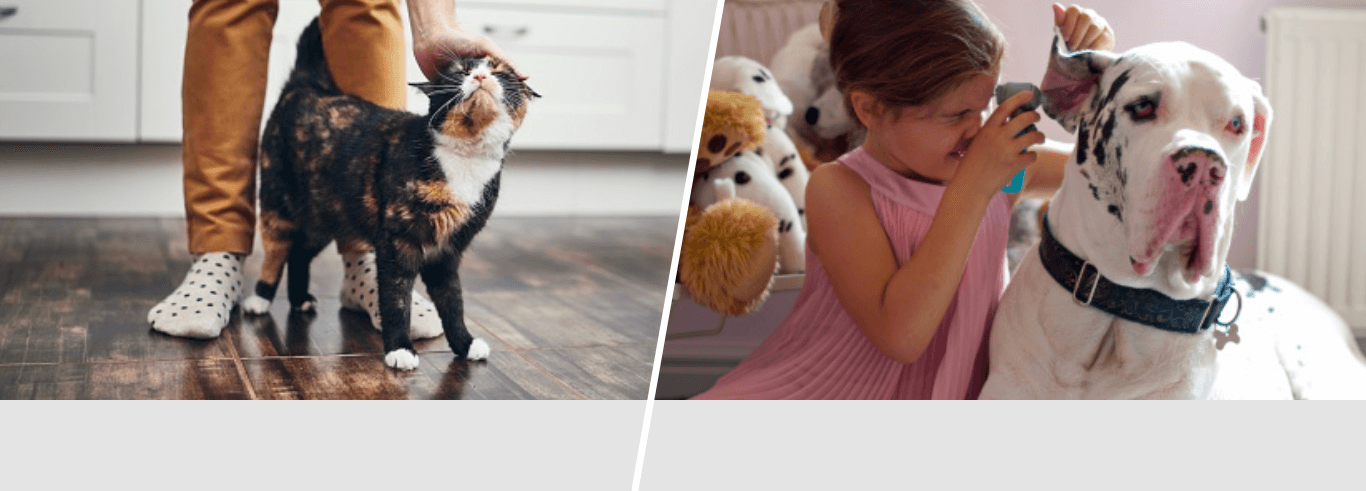What is demodectic mange?
Demodectic mange is a skin disease caused by microscopic mites. The mites are known as Demodex Canis and live in the hair follicles of cats and dogs, although it is less common in cats.
It may surprise you to learn that all dogs and cats (and humans) have a few of these mites living on their skin. They generally cause no harm, as long as the immune system is working properly.
However, demodectic mange can become more of a serious condition if ignored. Read on to find out more…
Which dogs does it affect?
Generally, demodectic mange affects younger dogs with poorly developed immune systems. An inadequate immune system can allow a rapid increase in the number of mites.
If the condition occurs in an older dog, it may indicate a defective or suppressed immune system.
Is it contagious?
Thankfully, demodectic mange in dogs is not contagious to humans or other animals. The mites can be transferred from the mother to the puppies within their first week of life, and most puppies are immune to the symptoms.
There are two known species of mite that cause mange in cats. One type, known as Demodex gatoi, is potentially contagious between cats.
What are the symptoms?
The main symptom of demodectic mange in cats and dogs is generally hair loss. Bald patches may appear on the face, usually around the eyes. The condition is known as localised demodectic mange if there are only a few patches. However, if the disease spreads over larger parts of the body, it can be diagnosed as generalised demodectic mange.
If your pet has a case of generalised demodectic mange, they may have crusty, inflamed skin or a general greasy, moist appearance.
What should I do if I think my pet has mange?
If your animal is experiencing hair loss, you should pay a visit to your vet. They will take skin scrapings and analyse them under a microscope to diagnose the disease. If your pet has more than the normal amount of demodex mites, they are likely to have mange.
Why is my dog affected?
If your dog has mange, it could be a sign of poorly developed immune system. Generally, as a dog matures, its immune system will mature too. But why has your puppy got mange, if most puppies are immune?
Poor development of the immune system is likely to be a genetic defect, which is when you will find generalised demodicosis. As it’s hereditary, the affected dog should not be bred, and the parents should not be bred again. You should also consider spaying or neutering your dog or cat.
However, localised demodex is a common condition of puppyhood.
Why is my cat affected?
Mange is less common in cats, so less is known about the causes. There are two species of mites that are associated with mange in cats. The first, Demodex gatoi, is potentially contagious and may be transmitted between cats. The second is Demotex cati, which is generally a sign of an impaired immune system or an underlying disease.
How is demodectic mange treated in dogs?
Localised demodectic mange is less serious, and it may clear up on its own as your puppy ages. If not, a prescribed topical medication will normally do the trick. Seek advice from your vet before taking this course of action.
Generalised demodectic mange requires a more vigorous treatment including the use of oral medications, dips and specific shampoos. Prior to the process of dipping, a cleansing routine containing benzoyl peroxide helps to remove oil and cellular debris.
After the first couple of dips, a skin scraping is performed to check for the presence of mites. Even if no mites are found, the process of dipping should be continued for at least another month.
If your dog has red, inflamed skin, they may have contracted a secondary skin infection, which may require antibiotic therapy.
How is mange treated in cats?
A range of topical treatments are available for cats. These can include lime sulfur dips, injectable ivermectin and other drugs.
Often vets will perform weekly skin scrapings to monitor your cat’s response to the treatment. If your cat is diagnosed with Demodex cati, they may need to carry out additional tests to check for any underlying issues to do with your cat’s immune system.
If treatment is successful, is it likely to recur?
With generalised demodectic mange, successful treatment may be costly and take a long time.
If your dog is still between the ages of twelve to eighteen months, a relapse is possible. This is because their immune system is not yet fully developed.
If your cat’s demodectic mange is caused by a disease of the immune system, maintenance therapy may be required to prevent relapses.
There is more than one type of mange; the other type is called sarcoptic mange which you can read about on our We Talk Pet blog.
It’s important to protect your dog in case they develop conditions such as demodectic mange. Keep your dog protected with Argos Pet Insurance provided by Pinnacle Insurance plc. Explore our dog insurance policies today.
 Sorry, our lines are now closed
Sorry, our lines are now closed



